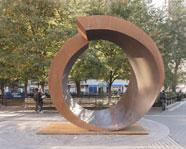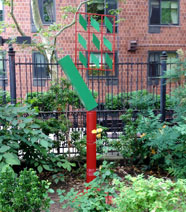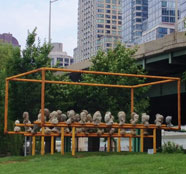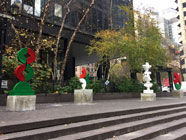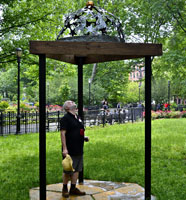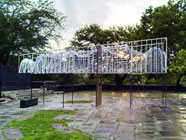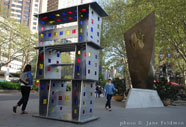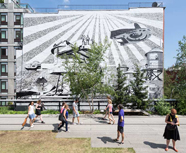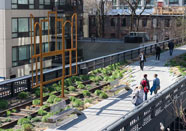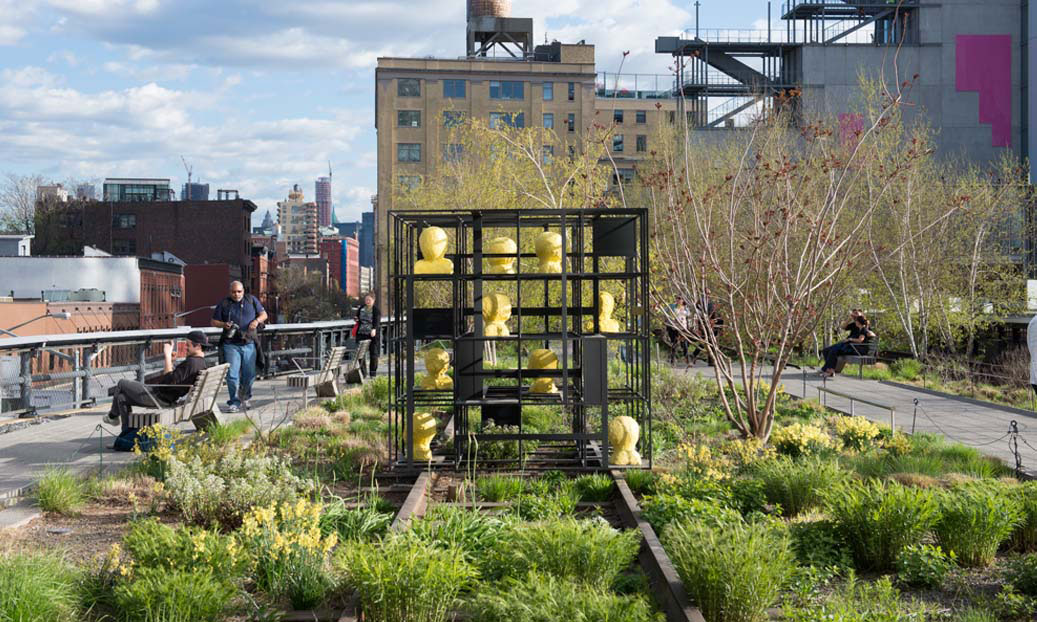Art in the Parks
Through collaborations with a diverse group of arts organizations and artists, Parks brings to the public both experimental and traditional art in many park locations. Please browse our list of current exhibits and our archives of past exhibits below. You can also see past grant opportunities or read more about the Art in the Parks Program.
Public Art Map and Guide
Find out which current exhibits are on display near you, and browse our permanent monument collection.
Search Current and Past Exhibits
2015
Manhattan
Beverly Pepper, My Circle
October 23, 2015 to May 31, 2016
Union Square Park, Manhattan
Map/Directions (in Google Maps)
Please note: This is a past exhibit that is no longer installed in the park.
In special recognition of Beverly Pepper’s 93rd birthday, the monumental sculpture My Circle, 2008 is on view in Union Square. The sculpture continues the artist’s contemplation of time, materiality and place, and is part of Curvae, her series of curved forms. By using Cor–Ten steel, a corrosion–resistant material that naturally and quickly develops a weathered–looking patina, Pepper is able to speed up the oxidation process, and in so doing suggest the concept of elapsed time through the sculpture’s skin of rust.
Like many of her monumental works, My Circle engages the viewer through the interplay of convex and concave forms. The use of opposing forces – vertical and horizontal, interior and exterior – creates a lyrical meditation of space that is at once dominant and intimate. The artist has stated that “Seeing, touching, and the physical sensory engagement is the way into my sculpture; my intention is that the meaning of my work rests in experiencing it, similar to the performing arts where listening and seeing the moments of a performance where meaning is revealed through experience.” She notes that My Circle, standing at fourteen feet tall in Cor–Ten steel, for her recalls an image from years ago relating to the symbolic character in Zen Buddhism where it is known as the Enso, a drawing in ink of an open or closed circle. The closed circle represents the totality of experience and life. The open circle represents the imperfection found in all things, and is known as the circle of enlightenment, its symbolism referring to the beginning and end of all things, the circle of life, and the connectedness of existence. What Pepper is drawn to within this narrative is the notion of the “connectedness of existence” and how we can connect people and populations through art.
This exhibition is presented by Marlborough Gallery and the Union Square Partnership.
![]()
Jorge Luis Rodriguez, Birdhouse, Fish Spine, Hummingbird and Palenque
June 20, 2015 to May 30, 2016
Harlem Art Park, Manhattan
Map/Directions (in Google Maps)
Please note: This is a past exhibit that is no longer installed in the park.
Birdhouse, Fish Spine, Hummingbird and Palenque are Rodriguez’s early works that are on view for the first time. He created these works shortly after Growth with scrap metal from the metal shop where his permanent work was fabricated. They equally represent Rodríguez’s interest in nature and the cultural exchange derived from travel to different countries. They are fabricated in painted welded steel, one of his favored techniques, and stand between seven and nine feet tall.
Birdhouse was inspired by Pablo Neruda’s poem “Las aves maltratadas,” (“The Brutalized Birds”) references the conduct of birds that assemble en masse in public places. Fish Spine references Rodríguez’s recollection of fishing adventures in the Caribbean Sea with his brother. The symbiotic relationship between fauna and flora is captured in Hummingbird. Palenque is inspired by Mayan architectural devices used to record the passing of celestial events.
In addition to the installation at East Harlem Art Park, Rodriguez’s sculpture The Oracle of the Past, Present and Future is on view at Tompkins Square. The Oracle of the Past, Present and Future in the East Village and Birdhouse, Fish Spine, Hummingbird and Palenque in Harlem celebrate the 30th Anniversary of Growth, Rodríguez’s large-scale, permanent work that was New York City’s first completed Percent for Art commission.
![]()
Art Students League, Model to Monument (M2M)
June 11, 2015 to May 15, 2016
Riverside Park South, Manhattan
Please note: This is a past exhibit that is no longer installed in the park.
The Art Students League of New York, one of America’s premier art schools, presents the Model to Monument Program (M2M), a collaboration with the New York City Department of Parks & Recreation that has culminated in the installation of seven sculptures on view along Riverside Park South from 59th to 69th Streets.
The sculptures were created by an international team of selected League students during a nine-month program. The pieces for this exhibition explore Patterns in Nature. The artists are: The sculptors participating in the fifth year of the M2M program are Lee Apt (Jubilation!), Caroline Bergonzi (Metamorphosis), Kate Jansyn (Fragment of an Angel), Sukyung Kim (Flow 1 – Cascade), Donat King (Man and Fish), Paola Morales (Thrive), and Ken Shih (Can love pervade spaceΑ). The collaborative sculpture in Van Cortlandt Park, Bronx for 2015 is entitled Gift of Life.
This work was made possible by the Art Students League’s Model to Monument Program and the Riverside Park Conservancy.
![]()
Mazeredo, Dialogue
November 30, 2015 to May 1, 2016
Dag Hammarskjold Plaza, Manhattan
Map/Directions (in Google Maps)
Please note: This is a past exhibit that is no longer installed in the park.
Babel, Butterfly, Dialogue, and Communication, four sculptures by Brazilian artist Mazeredo are on view in Dag Hammarskjold Plaza. She translates the sounds she hears in Brazil into vibrant colors and shapes that make up her sculptures. One of her most ubiquitous shapes is the abstracted mouth form. For example, Babel depicts mouths arguing as they ascend the tower to discuss the harmony of human dialogue to solve differences.
This exhibition is presented by the Friends of Dag Hammarskjold.
![]()
Jorge Luis Rodriguez, Oracle of the Past, Present and Future
June 6, 2015 to May 1, 2016
Tompkins Square Park, Manhattan
Please note: This is a past exhibit that is no longer installed in the park.
The Oracle of the Past, Present and Future is a 12-foot-tall structure that consists of geometric interlocking parts with elements of steel, wood, glass, and a magnificent dome that adds to its mystical symbolism. The work is inspired by the study of celestial bodies: the influence of the sun, moon, planets and zodiac constellations on human affairs and the natural world. Rodriguez invites the public to consider the mysteries of astrology and engage in contemplation and inner reflection while walking through the sculpture. The sculpture is located on the lawn just inside Tompkins Square Park at St. Mark’s Place and Avenue A.
In addition to the installation at Tompkins Square, four sculptures will accompany his permanent sculpture Growth at the East Harlem Art Park at 120th Street and Sylvan Place. "I have tried to capture the interaction between trees, birds, insects, flowers, and man. My sculpture may portray a seed sprouting from the ground, an insect transforming into a flower, or a bird changing into a tree. I hope to create an art piece that will serve as a source of enjoyment and inspiration to the community,” stated Rodríguez about Growth in 1985. These additional artworks echo his original concept as they emerge from different areas of the park.
The Oracle of the Past, Present and Future in the East Village and Birdhouse, Fish Spine, Hummingbird and Palenque in Harlem celebrate the 30th Anniversary of Growth, Rodríguez’s large-scale, permanent work that was New York City’s first completed Percent for Art commission.
![]()
Jessica Feldman, Jerome W Haferd & K Brandt Knapp, caesura: a forum
June 20, 2015 to April 15, 2016
Marcus Garvey Park, Manhattan
Map/Directions (in Google Maps)
Please note: This is a past exhibit that is no longer installed in the park.
Located on the Acropolis of Marcus Garvey Park, caesura: a forum by artist Jessica Feldman and architects Jerome W Haferd & K Brandt Knapp is inspired by the park’s iconic antebellum Mount Morris Fire Watchtower, and by Harlem’s vibrant tradition of activism and rallies. The bell is silent now, as the tower was temporarily dismantled in 2015 as the first phase for its reconstruction. Simultaneously, Harlem is undergoing dynamic change and New York City is experiencing a resurgence of public culture. caesura seeks to temporarily fill an architectural gap – and create a social space – by echoing and inverting the form and function of the absent tower. Like the bell, caesura aims to call up the neighborhood, to preserve and revitalize Harlem’s histories, and to connect newer and older community members to each other, by reactivating this site for congregation, viewing, and listening. The installation will reframe history with a temporary structure and sound. A “caesura” is a break or pause, a place to catch your breath, most specifically in ancient spoken-word art.
The architectural component of this piece begins at the Acropolis ground as an open-air, steel frame that supports a “horizontal tower”, which the viewer can pass through and meander under. In the center of the piece, a flattened “bell” made of reflective steel.
The sonic component of the piece consists of Feldman’s interactive composition, made up of bell sounds and voices. Historical and contemporary recordings and live-streaming voices from speeches, rallies, chants, and assemblies in Harlem are alternated with a through-composed layer of echoing bells. Analogous to a megaphone, the formal profile of the tower has been tipped sideways, allowing sound to be projected outward. Taut, translucent film runs through this shape and is mounted with electromagnetic transducers that turn the material into a speaker, allowing sound to pour down from the spaces in between the arches above visitors. A microphone mounted at the entrance to the installation allows visitors to broadcast their own voices through the piece. Those not present can participate through an interactive online component, allowing them to trigger the bell and contribute their own live audio to the arches. New and old histories are recorded, spliced, and digitally scripted together, activating the acropolis throughout the day.
This exhibition is co-presented with the Harlem Arts Festival, Marcus Garvey Park Alliance, and Mount Morris Park Community Improvement Association (MMPCIA).
![]()
Don Gummer, Don Gummer on Broadway
May 4, 2015 to March 31, 2016
Broadway Malls, Manhattan
Please note: This is a past exhibit that is no longer installed in the park.
Don Gummer on Broadway will highlight five examples of new work from Gummer’s haiku series, created in 2014 and 2015, which will be shown for the first time and were created especially for this exhibition. Four additional works dating from 2011 and 2012 will also be included in the exhibition. The sculptures range in height from eight feet to 14 feet.
“I first became interested in haiku poems because of the simplicity of their structure,” stated the artist. “Three lines stacked together containing 17 syllables. Five in the first line, seven in the middle, and five in the third line. I thought of substituting shapes for the syllables and instead of writing a poem with three sentences and 17 syllables, I made a sculpture with three vertical sections and 17 shapes, five in the bottom section, seven in the middle, and five in the top section. The three sections are separated by horizontal, linear flat rectangles, my version of lined paper.
“I thought that making a series of sculptures that shared a common structural theme would unite them along their shared route on Broadway. I also wanted to see how much variety I could create within a given set of rules. Five sculptures are based on the haiku idea and the other four sculptures have similar stacked elements, and I think they structurally relate to the others.”
A cell phone tour, in English and Spanish, which will include the artist’s commentary, is funded by Con Edison.
The exhibition includes: 12-12-12 at Columbus Circle; Mondrian at Dante Square; Complex Apartment at 72nd Street; Figure 8 at 79th Street; Open House at 96th Street; High Rise at 103rd Street; Open Eyes at 117th Street; Intersection at Montefiore Square, After Rome at 157th Street.
This exhibition is presented by the Broadway Malls Association and Morrison Gallery.
![]()
Kerry James Marshall, Above the Line
June 2015 to March 2016
The High Line, Manhattan
Map/Directions (in Google Maps)
Please note: This is a past exhibit that is no longer installed in the park.
Through compelling portraiture and both intimate and disquieting scenes of domestic life, Kerry James Marshall comments on contemporary and art historical depictions of black identity. Born in Birmingham, Alabama, raised in South Central Los Angeles in the 1970s, and currently based in Chicago, Marshall is acutely sensitive to his own social responsibility as an artist. The artist plunges his work into an exploration of race-consciousness, painting “unequivocally, emphatically black figures,” through whose depiction he articulates his intention to “reclaim the image of blackness as an emblem of power.” Marshall has been commissioned to complete numerous permanent public works at locations including the Legler Branch Library in Chicago, The Print Center in Philadelphia, and the San Francisco Museum of Modern Art’s Haas Atrium.
For the High Line, Marshall presents a large-scale, hand-painted mural adapted specifically for the High Line. Titled Above the Line, the mural is an extension of the artist’s Dailies series, specifically the cartoon strip “Rhythm Mastr,” an epic narrative of the struggle between tradition and modernity within the Afro-diasporic worldview. The works address the lack of black superheroes found in American comics, and raise historical and philosophical questions in black vernacular English. This particular comic painting, Above the Line, imagines the redevelopment of rooftop water tanks as luxury homes and condominiums.
This exhibition is presented by Friends of the High Line
![]()
Various Artists, Panorama
April 23, 2015 to March 2016
The High Line, Manhattan
Please note: This is a past exhibit that is no longer installed in the park.
Panorama is an open-air exhibition that takes inspiration from the High Line as an urban park cutting straight through the city, creating new vistas and vantage points onto the surrounding natural and man-made landscapes. The High Line is the ideal stage for this series of sculptures and installations, all of which explore the act of seeing and understanding the spectacle of nature. The exhibition challenges historical notions of the sublime, quasi-religious experiences of “untouched” nature, and the debate on the manicured versus the ostensibly natural garden, opening up the possibility for experiencing nature in its necessarily human-impacted state. *Olafur Eliasson’s The Collectivity Project will be on view from mid-May to mid-September 2015.
Panorama will feature eleven international artists: Mariana Castillo Deball, Olafur Eliasson, Elmgreen & Dragset, Ryan Gander, Kris Martin, Damián Ortega, Gabriel Sierra, Katrín Sigurðardóttir, Yutaka Sone, Kaari Upson, Andro Wekua,
This exhibition is presented by the Friends of the High Line.
![]()
Rashid Johnson, Blocks
May 2015 to March 2016
The High Line, Manhattan
Please note: This is a past exhibit that is no longer installed in the park.
Inspired by a childhood steeped in African American cultural influences, Rashid Johnson creates layered artworks that engage a conversation between personal biography and the implied gravitas of larger cultural and historical narratives. Johnson works predominantly in mixed media sculptures and paintings, combining bare materials such as mirror, wood, and shea butter with loaded iconic objects including record covers, CB radios, historical books, and common domestic objects. Throughout his career, Johnson has explored the ways in which we form our sense of belonging to races and communities, investigating the relationship between familiar objects and identity.
For his High Line Commission, Johnson built one of his minimalist three-dimensional steel black grids, which houses a variety of objects including busts painted to resemble shea butter (a material commonly used by the artist), and acts as a living greenhouse as plants on the High Line begin to intertwine with the sculpture over the year of its installation. Playing with forms taken from the Minimalist tradition – Sol LeWitt’s white open cubes come to mind – Johnson turns them into a reflection on blackness by breaking the rational structure open and embedding loaded objects within it.
Installed in an oblong island of plants growing between pathways on the High Line just south of The Standard, High Line, the sculpture will change over the course of its installation, the empty rectilinear vessel becoming a horticultural container as the seasons pass. The work reflects the artist’s ongoing interest in a line from a book by Lawrence Weiner called “Something to Put Something On,” in which the concept “table” is explained as “something to put something on.” This semiotic explication resonates with Johnson, who pushes its implications toward thinking about the ways in which lives, cultures, and historical arcs are a mere practice of putting some things on top other things that are imagined to be taken as given, such as the exemplary case of the table.
This exhibition is presented by the Friends of the High Line.
![]()
